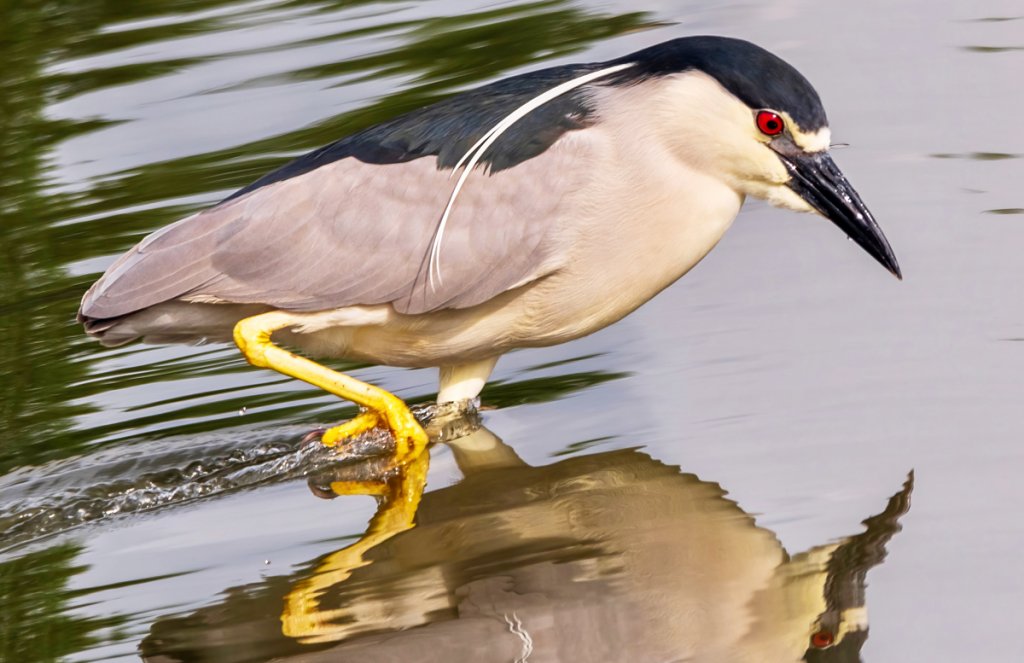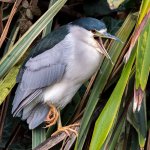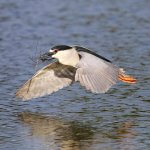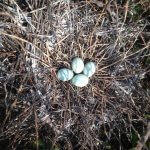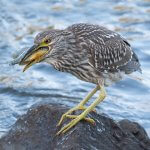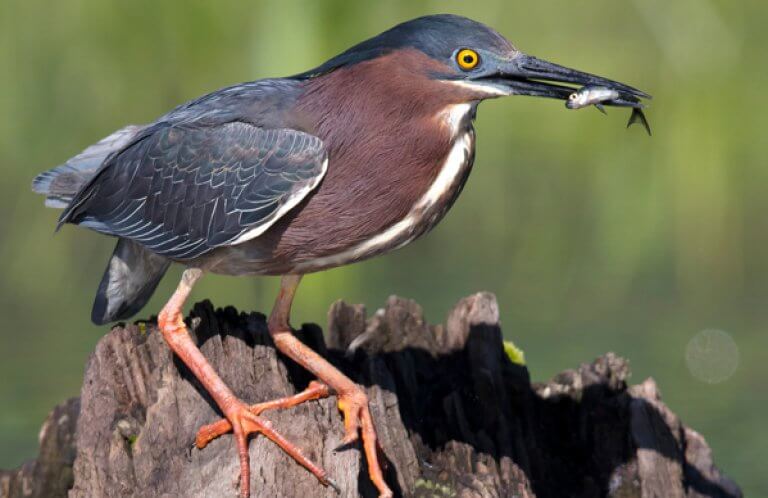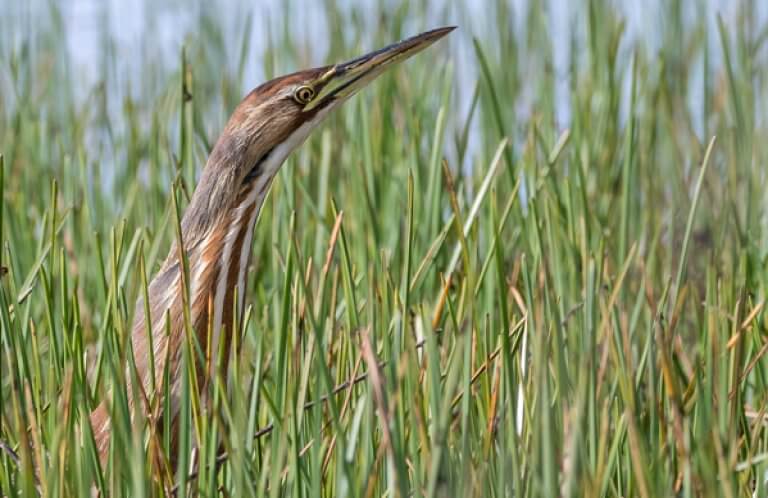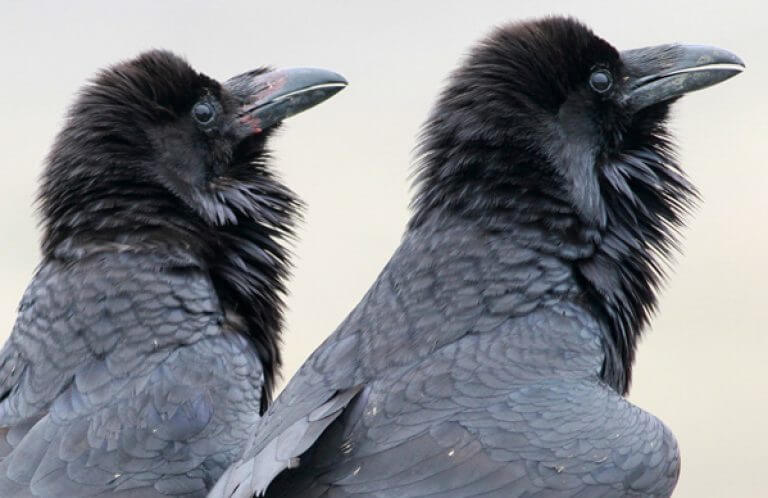About the Black-crowned Night Heron
The Black-crowned Night Heron is a small and sturdy waterbird, with relatively short legs, neck, and bill – somewhat similar to the Green Heron in its proportions. The adult is light gray with a black back and crown, set off by long, narrow white head plumes during the breeding season. Both sexes have yellow-green legs, which turn pink during the breeding season.
An immature night heron may sometimes be mistaken for an American Bittern, since the young are brown with streaky backs and underparts and pale-spotted wings. Immature Black-crowned Night Herons do not acquire fully adult plumage until their third year.
While relatively common, the Black-crowned Night Heron can often be hard to detect, since it is most active in the crepuscular (early evening) and nighttime hours.
Twilight Tendencies
The reason for the Black-crowned Night Heron's crepuscular habits is simple: it can feed without competition from waterbirds which use the same habitats during the daytime. One glance at this bird reveals its nocturnal tendencies – large, light-gathering red eyes give it excellent vision in low light, and a counter-shaded plumage pattern (dark above and light below) keeps its camouflaged from night predators and invisible to potential prey.
During the day this heron species stays hidden, roosting under the cover of dense trees in groups of up to 100 birds. Groups fly from these hidden roosts at twilight, moving to their feeding grounds and returning to the roost the next morning.
Songs and Sounds
The Black-crowned Night Heron's most often-heard call is a distinctive, squawking “kwok,” somewhat similar to that of a Common Raven's. This sound-alike call, often heard in flight, likely inspired this heron's scientific name, Nycticorax nycticorax, which means “night raven.”
Breeding and Feeding
Snapping and Stretching
The Black-crowned Night Heron is a colonial nester, similar to relatives such as the Great Blue Heron and Great Egret. It frequently nests alongside these species and other herons, ibises, egrets, and cormorants, sometimes gathering in same-species “neighborhoods” of dozens of nests per tree. Although the nest is usually built in a low tree or shrub, some will nest on cliff ledges or even on the ground. Colonies are usually sited on islands, in swamps, or over water, most likely to minimize predation or other outside disturbance.
The male night heron initiates courtship by claiming a nest site and beginning a complicated display, erecting its white head plumes while snapping its beak, stretching its neck up and forwards, and making hissing sounds. The male will grasp twigs while displaying and present them to prospective mates. Once a pair forms, the male will continue to bring sticks to his mate, eventually joining her in building the platform nest of sticks. The pair often reuses twigs from old nests while building and may even steal them from neighboring nests.

After mating, the female lays a clutch of 3-5 eggs. Both adults take turns incubating the pale blue-green eggs for almost a month, changing places with an elaborate ceremony that involves vocalizations, plumage fluffing, and erecting the head feathers. On hot days, the adult birds may wet their abdominal feathers prior to settling atop the eggs to keep them cool. After hatching, both parents continue to brood the nestlings, which grow quickly and leave the nest after two weeks. Competition between chicks while in the nest can be deadly, with siblicide a common occurrence, particularly when food is scarce.
The Black-crowned Night Heron is generally a solitary feeder, standing quietly at the water's edge or in shallows, then grabbing prey that comes within reach. It may attract fish by dipping its bill into the water and vibrating it rapidly, making a disturbance that lures in prey.
This heron feeds mainly on fish, but is opportunistic, also taking crayfish, amphibians, snakes, rodents, and the eggs and young of other birds. It readily scavenges carrion and will visit landfills for scraps and garbage.
Region and Range

The Black-crowned Night Heron is the most widespread heron in the world, breeding on every continent except Antarctica and Australia. In North America, it's found from Quebec south through coastal Mexico, as well as locally in Central America and the Caribbean. In Hawai'i this bird is known as the 'Auku'u, and is diurnal (active during the day), probably because of less competition for food on the archipelago. Old World populations of Black-crowned Night Heron occur from Europe to Japan, Africa, and India.
North American populations are partially migratory. Although some linger north, most travel to winter in the southern United States, Mexico, Central America, and the Caribbean.
Four subspecies of Black-crowned Night Heron have been described, a rather small number for such a widely-distributed species.
Conservation

Help support ABC's conservation mission!
Although the Black-crowned Night Heron remains fairly common throughout its wide range, it faces an ever-growing list of threats. Habitat loss, particularly due to rising water levels precipitated by climate change, is a major challenge to this species and other water birds. This bird's fish-heavy diet puts it at risk from accumulated pesticides and other toxins in its prey. Trash pollution along shorelines, particularly by plastics, is another significant problem. Black-crowned Night Herons and other sea and shore birds, ranging from the Laysan Albatross to the American Oystercatcher, often mistake plastic trash for food, with fatal results. Outside of North America, this species faces additional threats from hunting of adults and chicks and harvesting of their eggs for food and traditional medicine.
In late 2020, ABC and partners started the SPLASh (Stopping Plastics and Litter Along Shorelines) program to address trash pollution problems along Texas's coast. SPLASh works to reduce this threat to birds and all other wildlife by conducting community cleanups and by raising awareness through education and outreach programs.
Get Involved
Policies enacted by the U.S. Congress and federal agencies have a huge impact on seabirds. You can help shape these rules for the better by telling lawmakers to prioritize birds and bird-friendly measures. To get started, visit ABC's Action Center.
Plastics pose a deadly threat to seabirds around the world. You can help seabirds by reducing your daily use of plastics. To learn more and get started, visit our Plastics page.
American Bird Conservancy and partners are creating predator-free nest sites for vulnerable seabird species, reducing fishery impacts, and much more. This is a monumental undertaking, requiring the support of many, and you can help by making a gift today.





































